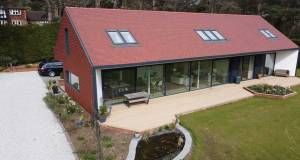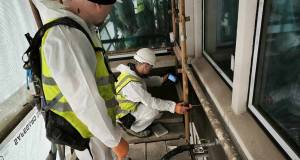
- Marketplace
- Posted
A Proctor Group call for consideration of moisture balance issues
This article was originally published in issue 37 of Passive House Plus magazine. Want immediate access to all back issues and exclusive extra content? Click here to subscribe for as little as €10, or click here to receive the next issue free of charge
According to APG technical director Iain Fairnington, a balance of factors is key to producing a healthy building envelope that protects the occupants.
“One of the features of balancing these principals can involve calculations to assess condensation and / or moisture risks,” said Fairnington. “Glaser calculations can do this but can have limitations, which a WUFI calculation can help overcome – for example with rain and drying out of residual moisture in the construction.” Fairnington said that a WUFI calculation to BS EN 15026 can help establish the effect that different vapour control layers (VCL) can have on the structure, and on whether a VCL is critical in a given case. “It’s difficult to argue that a VCL isn’t a good thing but similar to the first Covid-19 vaccination injection, a VCL may reduce the moisture risks to acceptable levels but shouldn’t be relied upon as the sole method of protection. Remember a VCL is a vapour control layer,” said Fairnington, “not a vapour barrier – an antiquated term that led to its over reliance.
“Generally, where the insulation is placed externally a VCL is less critical, especially where the airtightness layer is considered in the external vapour permeable membrane, compared with insulation solely between framing behind the sheathing board,” said Fairnington, adding that this has led to the introduction of externally applied, self-adhered, vapour-permeable yet airtight membranes like Wraptite.
“It is these properties of Wraptite – a selfadhered, airtight, yet vapour permeable membrane – that allows it to be placed on the external face of the sheathing board,” he said. “This allows for temporary water protection, airtightness and long-term vapour permeability, which along with the correct balance of insulation, means a VCL may be less critical. But it’s important to assess this fully on a project-by-project basis.”
Fairnington said that while there is little doubt that VCLs – especially in the case of variable resistance membranes – can help to reduce the moisture flow through a building envelope in many applications, they become less critical in some areas, depending on insulation placement. “For example, when placing insulation purely in between the frame of a timber frame building, the moisture risk may be too high to omit the VCL and therefore should be used to reduce vapour progressing through the structural frame,” he said. “However, if this is balanced with insulation placed external to the structural frame, the dew point potential is reduced due to the warm frame and the VCL becomes less critical. But it’s still good practice.”
“A good appreciation of the key balancing of heat, air and moisture movement can work together for the benefit of the industry,” Fairnington said. “APG have many VCLs in our range, one being a variable VCL, and it is not our position to persuade the industry not to use them. Our stance is to show people that VCLs should not be relied upon solely to reduce moisture build up but can have benefits when balanced with other factors.”
APG now have Wraptite and Procheck Adapt passed as certified passive house components, tested by the Passive House Institute.
APG’s technical back up service includes Glaser and / or WUFI calculation services where appropriate to show the robustness of the proposed constructions, along with toolbox talks (virtual if required), specification guidance and site visits (dependant on Covid restrictions), which can give a compliance report showing areas that are well installed and areas of improvement in the installation.
Related items
-
 New Ejot profile cuts thermal bridging losses by 25mm insulation equivalent
New Ejot profile cuts thermal bridging losses by 25mm insulation equivalent -
 Build Homes Better updates Isoquick certification to tackle brick support challenge
Build Homes Better updates Isoquick certification to tackle brick support challenge -
 Ecological Building Systems expands UK and Irish straw panel construction with EcoCocon deal
Ecological Building Systems expands UK and Irish straw panel construction with EcoCocon deal -
 Focus on better buildings, not better spreadsheets
Focus on better buildings, not better spreadsheets -
 MBC offers total passive house envelope solutions
MBC offers total passive house envelope solutions -
 Historic Dublin building retrofitted with cutting edge insulation
Historic Dublin building retrofitted with cutting edge insulation

